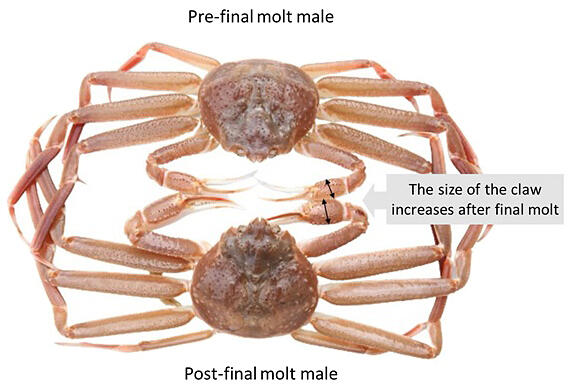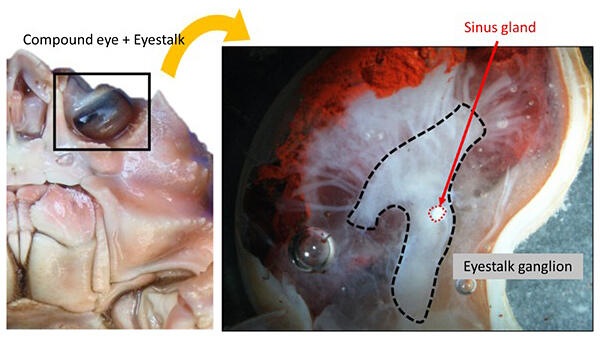Crustaceans such as shrimps and crabs repeatedly molt throughout their lives, increasing their body size and reproducing accordingly. However, the number of times that snow crabs molt in their lifetime is fixed, with males molting 10 to 12 times and females molting 10 times from the juvenile stage before joining the main breeding group. Males are known to have enlarged claws and become aggressive after the final (terminal) molt. However, the mechanism behind this phenomenon is largely unknown.
A joint research group led by Assistant Professor Kenji Toyota of the Noto Marine Laboratory, Institute of Nature and Environmental Technology, Kanazawa University, Senior Researcher Takeo Yamamoto and Senior Researcher Miyuki Mekuchi of the Japan Fisheries Research and Education Agency (FRA), Technical Group Leader Tomoko Mori and Professor Shuji Shigenobu of the National Institute for Basic Biology, Associate Professor Shinichi Miyagawa of Tokyo University of Science, Associate Professor Masaru Ihara of Kochi University, Professor Tsuyoshi Ohira of Kanagawa University, and others have revealed changes in the physiology of male snow crabs before and after their final molt. The findings were published in Scientific Reports.

Provided by Kanazawa University
The research group focused on a hormone molecule called methyl farnesoate (MF) and compared its blood levels in male snow crabs before and after the final molt. They found that the MF level was increased after the final molt. Additionally, the researchers performed comprehensive gene expression analysis of the eyestalk ganglion, which controls the biosynthesis and secretion of MF. The results revealed that the expression of MF‐degrading enzyme genes was suppressed in the males after the final molt, resulting in increased blood concentrations. Furthermore, biogenic amine‐related pathways, which are known to promote behavioral changes in crustaceans and closely related insects, were activated in the males after final molting.
These results suggested that biogenic amines could be involved in the behavioral changes that cause males to become aggressive after the final molt. They also suggest that MF and biogenic amines regulate the reproductive behavior of male snow crabs.

Provided by Kanazawa University
Snow crabs are an important fishery resource not only in Japan but also worldwide. Therefore, understanding their reproductive biology is important not only for promoting resource management but also for developing efficient aquaculture techniques. Based on the results of this study, the development of a technology to artificially control the final molt will contribute to establishing an efficient method for producing post‐final molt males with high fishery value.
Journal Information
Publication: Scientific Reports
Title: Eyestalk transcriptome and methyl farnesoate titers provide insight into the physiological changes in the male snow crab, Chionoecetes opilio, after its terminal molt
DOI: 10.1038/s41598‐023‐34159‐y
This article has been translated by JST with permission from The Science News Ltd. (https://sci-news.co.jp/). Unauthorized reproduction of the article and photographs is prohibited.




